|
December 1942 QST
 Table of Contents Table of Contents
Wax nostalgic about and learn from the history of early electronics. See articles
from
QST, published December 1915 - present (visit ARRL
for info). All copyrights hereby acknowledged.
|
December 1942 was just a year into America's
"official" involvement in World War II. Already, both wired and wireless communications
had made major advances and were indisputably vital in both the logistical and strategic
aspects of troop movement, supply chains, fighting battles, and evacuation of wounded
personnel. It also played a large part in propaganda campaigns. This was all true
for both Axis and Allied forces. Ham radio operators provided a huge boost to the
Signal Corps because they came at least partially trained for the jobs. These dozen
and a half photos from the field exhibit the state of the art at the time. Maybe
you'll recognize a father, grandfather, or uncle in one of them. For that matter,
you might even recognize a mother, grandmother, or aunt.
In the Field with the Signal Corps
A Picture-Story of U. S. Army Field Radio Equipment
On these pages are pictured some of the types of field radio equipment now employed
by the U. S. Army, ranging from the paratrooper's "handie-talkie" to powerful motorized
trailer-truck base sets. This is Signal Corps equipment - highly developed, each
type especially perfected for its own individual job by intensive field trials and
the acid test of actual military operation.
It is this equipment which the hams (and the thousands of will-be hams who are
now their buddies) in the Signal Corps are learning to use in training camps around
the nation. It is the equipment some of them have already set up on foreign soil
and operated in actual combat with the enemy.
Thousands of these units are now in operation. Thousands more are pouring from
the production lines weekly. On these units, and the men who operate them, rest
a vital responsibility. For the performance of the army in the field can be no better
than the equipment it possesses. And in modern warfare communications constitutes
the nerve system indispensable for coordination and control of successful operations.
This, then, is the equipment with which the Signal-Corps will do its part to
win the war.
Portable field equipment for all branches of the service.
|
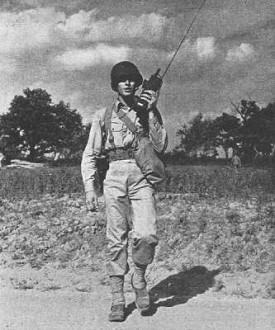
The "handle-talkie" fits its name in every sense of the word.
Smallest field unit of the Signal Corps, it is not much larger or heavier than a
conventional handset.
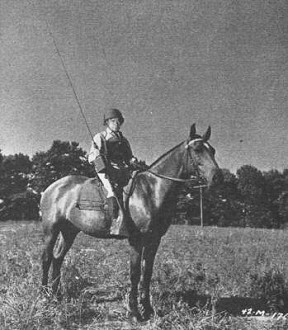
Cavalry" guidon radio." Although designed - for mounting in a
stirrup-boot, it can also be used by a soldier on foot or mounted on a vehicle.
Official U. S. Signal Corps Photos.
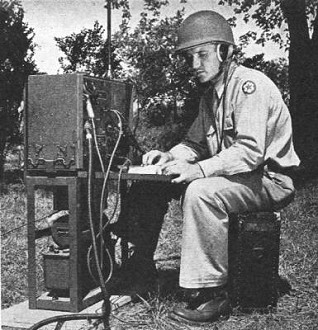
Compact 'phone-c.w. field unit with transmitter and receiver
in the same cabinet, using dynamotor power supply (underneath).
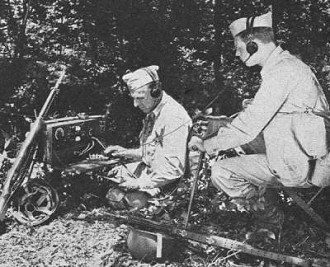
Next step above the hand portables is this small 'phone-c.w.
medium-frequency hand-generator-powered combined transmitter-receiver. Readily transported
by a two-man crew, one to operate and one to crank.
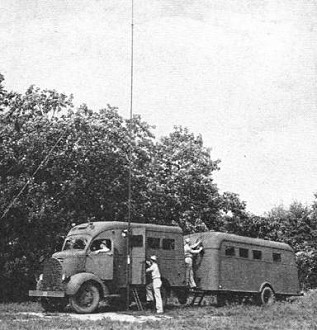
SCR 197 field-base unit. The high-power rack-mounted transmitter
installed in the truck, complete with power source, may be remotely-controlled from
trailer at message center.
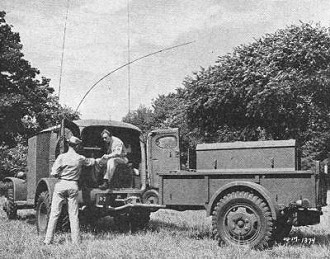
SCR 299, latest field-base unit. Transmitter and receiving position
in truck, gas-driven generator in trailer. The flexible "trolley" - style vertical
antenna can be pulled down horizontal from the interior in transit, or the station
can be operated in motion at high speed.
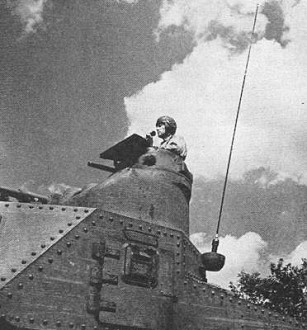
Talking hack from a tank, Note the spring-mounted whip-type vertical
with its husky base support.
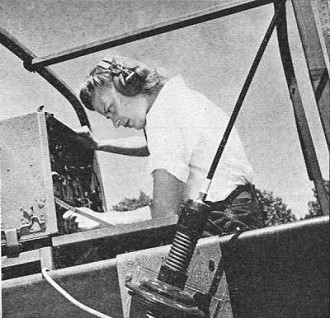
Another girl mechanic running a field test on a mobile unit. There's
a close-up of the spring-type vertical antenna base mounting, too, in case you didn't
notice.
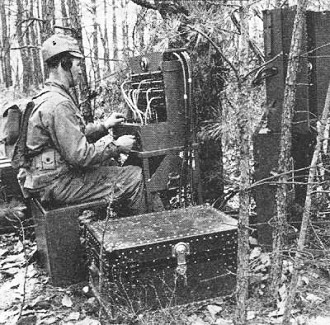
The wire men play a vital part, too. Field telephone lines to
combat units terminate at this portable command-post switchboard, its operator in
full battle dress.
Official U. S. Signal Corps Photos.
|
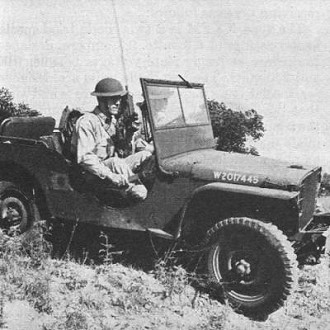
Two midgets - and both tops in their class. A jeep and a handie-talkie
on reconnaissance duty. Operator is strapped in by safety belt for travel over rough
terrain.
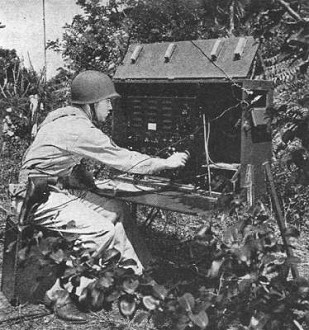
Workhorse of the Signal Corps is this BC-191-type transmitter,
seen here in typical operation at a field post. Remotely controlled from central
receiving point (shown at center left).
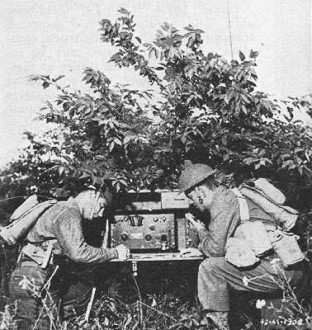
Remote-control operating and receiving position with two complete
channels. Transmitters (see photo at upper left) are remotely controlled for break-in.
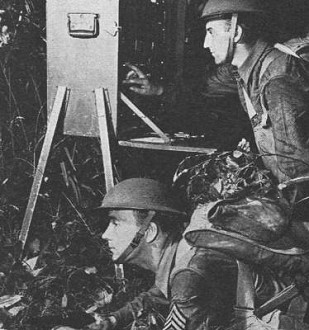
On the alert. Fully armed and carrying complete packs, Signal
Corps men in combat operate a portable field transmitter under protective cover.
Official U. S. Signal Corps Photos.
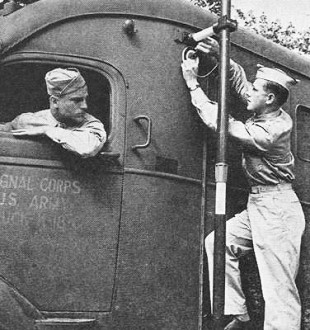
Antenna adjustment on the SCR 197's massive vertical, supported
by husky ceramic mounting insulators.
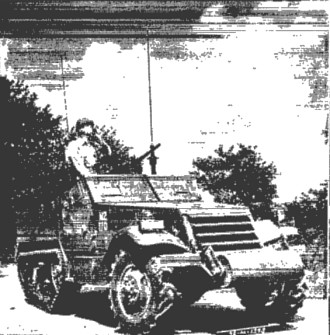
Radio-equipped half-track for attack communication in the armored
forces.
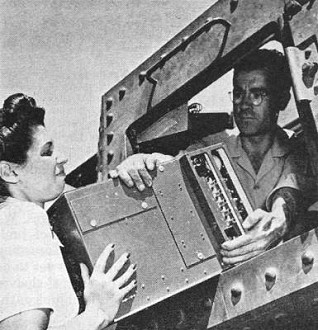
Civilian radio mechanics from the Signal Corps General Development
Labs making a radio installation in an M-3 tank. This is some of the latest f.m.
equipment for the armored forces. Yes, there are women in the Signal Corps, too!
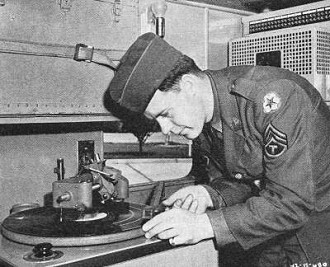
It's not all radio in the Signal Corps. Here is a soldier cutting
a transcription in a Signal Corps sound truck.
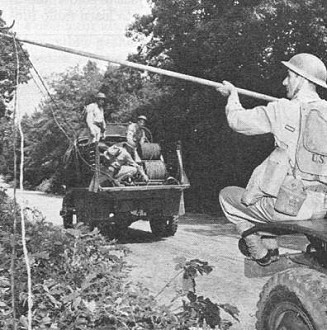
A wire-laying crew in action. They can lay 30 miles of telephone
cable a day.
|
Posted December 18, 2020
(updated from original post on 1/28/2016)
|



























